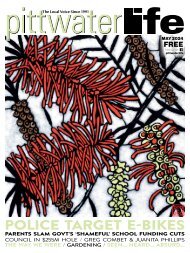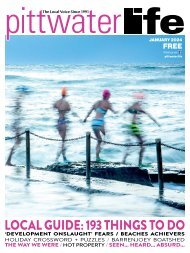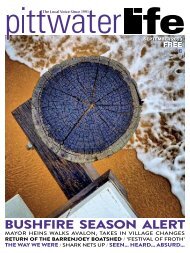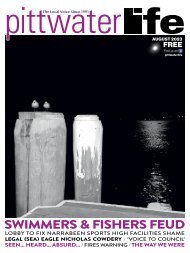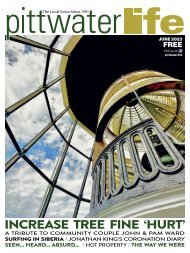Pittwater Life April 2017 Issue
Arrested Development. Straight Shooter. Help To "Shape 2028". ANZAC Day. Avalon Surf Swap. Easter Activities.
Arrested Development. Straight Shooter. Help To "Shape 2028". ANZAC Day. Avalon Surf Swap. Easter Activities.
You also want an ePaper? Increase the reach of your titles
YUMPU automatically turns print PDFs into web optimized ePapers that Google loves.
Scale to rate your hunger<br />
As the weather gets cooler<br />
we tend to eat more food.<br />
It’s essential for weight control<br />
to recognise and act on the<br />
feedback your body gives you<br />
about when and how much<br />
food you need to eat.<br />
To help you get in touch<br />
with your body, practise considering<br />
how hungry you are<br />
both before and after a meal.<br />
Rating your hunger helps<br />
you recognise whether you’re<br />
eating because you’re truly<br />
hungry.<br />
Similarly, rating your hunger<br />
after eating helps you to learn<br />
that you don’t need to eat<br />
until you are stuffed in order<br />
to survive.<br />
Use the Queensland Health<br />
Department’s Hunger Level<br />
Scale below to rate your hunger<br />
levels.<br />
1 – Starvation, physical pain.<br />
2 – Definite physical<br />
symptoms, headache. Lack<br />
of energy<br />
light-headed.<br />
3 – Beginning of physical signs<br />
of hunger.<br />
4 – Could eat if it were<br />
suggested.<br />
5 – Neutral.<br />
6 – Satisfied.<br />
7 – Feel food in stomach.<br />
8 – Stomach protrudes,<br />
beginning of mood<br />
alteration.<br />
9 – Bloated, definite mood<br />
alteration.<br />
10 – Definitely full; physical<br />
pain, numbness.<br />
Weight management is usually<br />
most successful when you<br />
wait until you are at a 3 before<br />
eating and then stop when<br />
you reach a rating of 6.<br />
If you are watching your<br />
weight it’s also important to<br />
aim for a regular eating pattern<br />
of meals and snacks.<br />
An unstructured eating pattern<br />
is more likely to include<br />
too many discretionary foods<br />
ie “junk foods” which means<br />
too much saturated fat, added<br />
sugars, added salt and kilojoules<br />
at the expense of fibre<br />
and important nutrients.<br />
Health & Wellbeing<br />
Celebrating 25 Years<br />
APRIL <strong>2017</strong> 45




